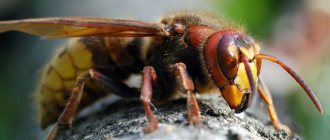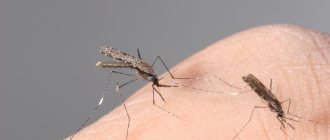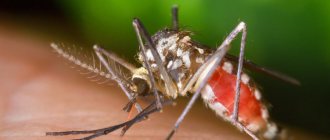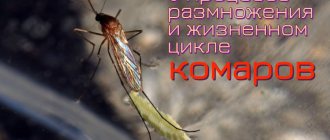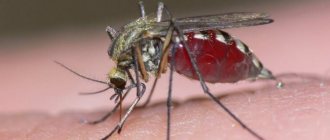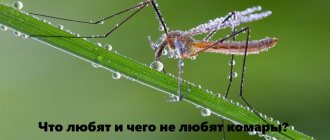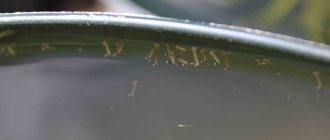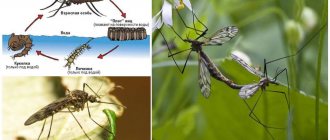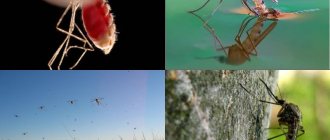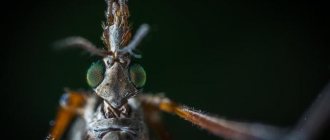Features of mosquito physiology
The average adult mosquito weighs 2 g, its body length does not exceed 3 mm. With such parameters, atmospheric conditions have a decisive influence on the movements of the insect:
- wind;
- rain;
- fog.
In calm, windless weather, the bloodsucker rises in flight no higher than 15 m, which is equivalent to 3rd floor windows. If the mosquito got into the apartment above, then with a greater degree of probability it was brought by a sharp gust of wind.
During rain, the coordination of mosquito movements is reduced; they cannot rise above the ground above 1–1.5 m.
In search of a solution to the mystery of how high a mosquito rises in flight, scientists studied the aerodynamics of the insect's movements in slow-motion, high-precision filming. It turned out that the wingspan of the bloodsucker is only 40 degrees, which is half that of bees.
An explanation for this fact is provided by nature itself: male mosquitoes feed on pollen, and females feed on the blood of humans and animals. There is no need for insects to climb to extreme heights from a survival point of view.
Moreover, at altitude the humidity and temperature of the environment changes, which reduces the life expectancy of the insect and prevents the laying of eggs. The only explanation for the presence of a bloodsucker on the roof is the presence of a damp, flooded attic there.
Facts about flight abilities
The female can boast of special achievements. Female representatives fly far to find a source of nutrition - blood. The speed of a mosquito is 3.2 km per hour. If absolutely necessary, insects fly to a maximum distance of 300 km. Provided that food supplies have been replenished beforehand. To cover such a distance you need to fly about 35 hours.
Flight range is not the most surprising thing. There is no exact data to what height insects can rise. Many experts insist that mosquitoes do not rise higher than 15 m above the ground, which is approximately the 3rd floor of a house. However, there are facts that mosquitoes were found on glass from the outside on the 22nd floor.
The mosquito weighs only 3 g. At the slightest breath of wind, it changes its route. Streams can carry it over long distances, both upward and to the side. Amazing behavior of blood-sucking creatures during the rain.
Aerodynamics features
Scientists from all over the world studied it. Japanese scientists managed to study the aerodynamics of flight. The filming was carried out in slow motion. They filmed in infrared radiation with a camera at a speed of 10 thousand frames per second. The results were published in journals in Japan and Great Britain.
Interesting!
During the research, it became known that during flight the wingspan is only 40 degrees. This is 2 times less than that of bees. With such physiological abilities, a small creature is not able to rise to a high level above the ground. However, the question of where mosquitoes cannot reach remains open.
Life cycle of a mosquito
When the female is ready, she attracts the male. Before this, she gorges herself, having found a warm-blooded creature. From food it extracts the necessary substances used for the production of eggs.
Interesting fact: while females prefer a predatory method of feeding, males feed exclusively on nectar from flowers.
At one time, females can lay from 150 to 280 eggs. They do this on the surface of the water or in damp soil. The eggs float in the liquid, after which the larvae hatch from them. They breathe through sinuses located on their abdomen and feed on small microorganisms. After absorbing enough food, they create a pupa around themselves. Inside the shell, the insect turns into a mosquito. His legs grow and wings form.
When the maturation process ends, the insect breaks through the cocoon and crawls out. The newborn mosquito waits for some time for its wings to dry before flying, then takes to the air and goes in search of food.
Depending on weather conditions, females can live from 40 to 120 days, males live half as long. When cold weather sets in, the creature can go into suspended animation and wait in this state for the onset of the warm season.
Mosquito: description, structure, characteristics. What does a mosquito look like?
The mosquito belongs to the order Diptera and the family of blood-sucking mosquitoes. Mosquitoes have lived on Earth for as much as 145 million years.
The mosquito has a thin body from 4 to 14 mm in length. The wings of a mosquito are transparent, they reach up to 3 cm in diameter and are covered with small scales. The mosquito's abdomen consists of ten segments. The mosquito's long legs end in two claws.
The color of a mosquito, in addition to the usual black or brown, can also be very unusual; green, yellow, orange and red mosquitoes are found in nature.
Interesting fact: among the large family of mosquitoes, there are also wingless species.
Mosquitoes also have a kind of antenna, consisting of 15 parts, on which the olfactory organs and auditory receptors are located, working on the principle of a temperature sensor. It is with the help of such an antenna that the mosquito finds its victim.
How high do mosquitoes and flies fly?
Flight of a mosquitoFlight of a mosquito
To which floor do mosquitoes fly is one of the frequently asked questions, since they can be found on both the 10th and 20th floors. There is no specific maximum height for a mosquito.
From a theoretical point of view, an insect can rise no higher than the third floor of a house. Gusts of wind hinder further progress upwards. However, these same flows can carry the pest to any height.
How high do mosquitoes fly?
Small creatures cannot fly higher than 15 m above ground level on their own. The body weight of an ordinary mosquito is about 3 g. The slightest wind currents impede movement and force it to change its trajectory. Based on natural instincts and natural needs, pests do not necessarily have to travel long distances upward. They try to stick to the ground, grass, and ponds with standing water.
Aerodynamics of a fly
Scientists compare the insect and its capabilities to a flying saucer. It can calmly hover in the air, make jerks in different directions without first gaining acceleration, quickly takes off, lands sharply, and holds perfectly on horizontal and vertical surfaces. The most important mystery for scientists that has not yet been solved is how it stays upside down on the ceiling and then calmly turns over during flight.
Interesting!
Having unraveled the mystery of aerodynamics, scientists will be able to create the perfect aircraft, which will become a major military achievement.
The flight path of a fly is difficult to calculate. She quickly changes direction, flies in zigzags, right, left, down, up. A quick, instant reaction is provided by a compound eye that allows you to see around its axis. It breaks into the air even before the person takes a decent swing.
Flight Features:
- Moving in different directions, hovering, maneuverability.
- Upside down location.
- The ability to fly long distances without stopping.
- High flight speed.
Not a single insect can compare with a fly in terms of aerodynamics and speed. The main goal of scientists is to solve the mystery.
Maximum performance for fly flights
The class of insects is unusually diverse. There are many orders, united by similar properties of body structure, individual organs, and method of nutrition.
The fly is classified as a dipteran. The lack of flying organs did not affect the quality or speed of movement.
Fly wingspan
The absence of an “extra” pair of wings allows you to work wonders: make quick flaps and easily maneuver in the air.
High mobility is provided by the halteres formed from the hind wings. When the paired organ is removed, flight will cease and the insect will join the ranks of crawling creatures.
Range
The distances that flies can fly amazes many scientists; they cover up to 3 km per hour without stopping. But in order to fly these distances, important reasons are needed.
Typically, a fly develops high speed indicators if it is very hungry, if it needs to lay eggs, and is prompted to this fast flight by the thirst for mating.
Insects begin to fly quickly in unfavorable weather conditions.
Typically, the activity of flies is observed in the summer; they are often found on the street, but at the end of the summer season they begin to move into people’s homes. They also love to live in outbuildings and sheds with livestock.
Height
Diptera insects are found almost everywhere. Scientists have proven that the flight height of a fly is limited. They, like birds, do not fly high into the sky.
For a comfortable existence, food is practically nearby. It’s not difficult to get food: there are dumps and dung heaps around, you can enjoy delicious jam, bread crumbs, and plant nectar.
Fly eating bread
The food is low, the shelter is nearby. There is no need to strive upward.
Scientists did not specifically conduct experiments trying to establish how high representatives of the group rise. Insects reach 5-10 floors. Residents of high-rise buildings claim that they noticed the pest on the 25-28th floors.
Researchers comment on the unusual phenomenon. They claim that insects do not rise to significant heights on their own. The maximum flight height of a fly depends on the wind.
Types of flight
Insect flight can be active or passive
How abilities are multiplied
According to official information, the flight height of a mosquito in the wild is limited to 5 meters. Males feed on nectar and plant pollen; there is no point in rising above the greenery. Females need blood, for which they look for a potential victim. Insects hunt animals, birds, and, if possible, attack people. There is no point in climbing to a height of more than 5 m.
Flying mosquito
In urban environments, mosquitoes en masse occupy the lower floors and do not reach the fourth floor on their own. However, you can meet the pest even on the roof of a building. There are several versions of how they get there:
- blown by the wind;
- fly out of the windows of the lower floors, then rise up;
- they live in basements, damp hallways, and climb up ventilation shafts and elevators.
City mosquitoes live and breed in damp basements and mines. The presence of a person is sensed by the smell of sweat, lactic acid, and carbon dioxide. Elementary instinct forces insects to make their way into human habitation and rise to great heights.
At what altitude were mosquitoes discovered - amazing facts
On a hot day, the walls of the building become very hot, and in the evening they begin to emit warm air currents that rise to the highest floors. Small mosquitoes fly up with them. Insects are found on skyscrapers, the 20th and 30th floors are common.
Flying mosquito
There is information that the pests flew to a height of 5 thousand km in the Himalayas. There are several versions of how they got there. They got in with people, initially getting into their belongings, travel bags, backpacks. Somehow the larvae were introduced, and then the adults appeared.
For blood-sucking creatures, the habitat is of greater importance - temperature within 20-25 degrees Celsius, high humidity. Accidental entry of pests into the upper floors shortens the life of the insect and prevents them from laying eggs in favorable places. It can fly to the roof and live in the attic if it leaks and water stagnates.
Factors that increase flight altitude
The size of the insect is about 3 mm in length, the weight of the mosquito is about 2 mg. With such dimensions, the trajectory of movement can easily be changed by the wind. The flight altitude of a mosquito directly depends on weather conditions.
- In the absence of wind, pests rise no more than 15 m above the ground, which is approximately equal to the third floor of a multi-story building.
- According to numerous reviews, they can easily rise to the height of a 9-story building. They were even found at 28. Movement over 15 m is facilitated by the wind, which picks up insects and lifts them upward. The number of pests decreases with each meter, but with a large number of bloodsuckers and on the fifth floor, you will need mosquito nets on the windows to protect your home from annoying bloodsuckers.
- Pests often live in damp basements of multi-story buildings, from there they calmly move up the ventilation shafts and through the elevator. At what height the insect will appear depends on the structure of the high-rise building. There is not much difference if there are shafts and an elevator.
Interesting!
Under the article, which contained information that the mosquito does not rise above the third floor, the maximum height is 15 m, numerous comments poured in. Eyewitnesses claimed that bloodsuckers haunted the 15th floor too. When asked where mosquitoes come from, they claim that they get into the room not through the ventilation grilles or entrance, but from the side of the balcony, where they were often found on the glass from the outside.
Mosquito flight altitude - interesting facts
In general, a mosquito that feeds on the nectar of flowering plants is a very mundane creature. Female mosquitoes drink the blood of humans and animals, which they need for reproduction, but mosquitoes do not lie in wait for their victims in the skies either, even those that bite birds (the so-called ornithophilous mosquitoes). The fact that in nature the mosquito is at the base of food chains does not contribute to the love of high flights - it itself, in the imago stage, is completely devoid of predatory habits, but everything is ready to feast on it with pleasure - including dragonflies and small birds.
In this case, you need to take into account the low weight of the mosquito, which easily becomes a toy of the wind and rising air currents. In the evening, intense jets of warm air rush upward from the sun-heated earth, and with them the mosquito sometimes rises tens of meters. If such an aeronaut happens to be near a residential or office high-rise building in the city, he is quite capable of flying into a window on the twenty-fifth floor. In concrete jungles, hot updrafts over asphalt are especially intense.
Another convenient way for insects to penetrate to the upper floors is ventilation and elevator shafts, where upward air movement is also observed. The prevailing humidity there is a plus for mosquitoes. Live, active mosquitoes were found in ventilation shafts on the 54th floor of a skyscraper in New York. They are almost certainly capable of climbing higher, it’s just that no one has recorded these records.
Mosquitoes thrive on the flat roofs of high-rise buildings if the drains there are not well organized. Females lay eggs in accumulations of stagnant water; they go down to residents’ apartments to hunt. True, on the roof there is a problem with the usual plant food, but recently scientists have discovered among synanthropic mosquitoes a tendency towards aphagia - the absence of the need for food at the stage of the adult insect. The entire life task of females comes down to mating, finding a source of fresh blood, laying eggs and dying. Perhaps insects find food on the flowers of indoor plants. Some of the inhabitants of the roofs return to the ground along with rainwater.
How high do mosquitoes fly?
Small creatures cannot fly higher than 15 m above ground level on their own. The body weight of an ordinary mosquito is about 3 g. The slightest wind currents impede movement and force it to change its trajectory. Based on natural instincts and natural needs, pests do not necessarily have to travel long distances upward. They try to stick to the ground, grass, and ponds with standing water.
On a note!
Insects rise to a height of up to 100 m from the surface of the earth. On the top floors of a multi-storey building it is necessary to install mosquito nets. This does not at all indicate the unique flying ability of a small creature, but it does indicate the presence of accompanying factors.
Flying mosquito in the rain
In Japan, scientists conducted an experiment in which they observed the flight of an insect under artificial rain. Mosquitoes were placed in a small transparent box, where droplets were simulated falling. The approximate weight of the latter was 8 mg, despite the fact that the mass of the insect is only 2 mg. It is not difficult to guess that their meeting will not end well for the mosquito.
If an insect sits on the surface and a drop falls on it from above, then it can go to the next world. If liquid gets on a mosquito while it is in flight, the trajectory of its movement is seriously changed. It begins to drift to the side, the height drops sharply. The drop flows down the body, parts of it remain on the paws and serve as additional weight. In this state, the insect, at best, can rise one meter.
The maximum flight altitude of a mosquito is approximately 15 meters, after which it needs to rest. Therefore, having taken off from the ground, in the absence of wind, he can reach the sixth floor. If an insect manages to fly inside a building, then it is gradually able to reach any floor, resting on staircases or in ventilation. In rainy weather, mosquitoes can only fly up a meter, because... constantly struggling with the drops falling on them.
Traditional methods
Advantages of folk remedies in the fight against flies: safety for humans and accessibility. The most familiar of them is mechanical. Insects are killed using a fly swatter (or rolled up newspaper). However, this method is tedious, especially without some skill. Yes, and there are traces of dead flies on the walls. But human resourcefulness knows no bounds: some people use a vacuum cleaner turned on at full power to fight flies.
Deception
If you take into account the life activity of flies, you can trick the insects into leaving the apartment. Here are two ways.
- Ventilation. Since the vital functions of winged pests “turn on” when the temperature rises above 15°C, you can thoroughly ventilate the apartment to force the “enemy” to leave the house.
- Blackout. Flies fly, which means they have the opportunity to get food only when it is light. Twilight forces insects to look for a more “friendly” habitat.
Flies are afraid of drafts, but at the same time they may not leave the apartment, but simply sit out in secluded corners. As soon as the windows are closed, the insects will make themselves known again.
"Aromatherapy"
There are odors that are extremely uncomfortable for flies. Diptera prefer to leave places that emit unpleasant odors. Here are three ways to help get rid of insects.
- Ethers. Do general cleaning using a solution of essential oils (two to three drops per liter of water) to wash walls, floors and cabinets. Flies cannot stand the smell of cloves, citronella, peppermint, eucalyptus, and lemongrass.
- Alcohol. Using a spray bottle, spray vodka in the room where the flies live.
- Seasonings. Grind a handful of dry clove buds in your palms and place in a vase or any bowl.
Insects do not like the smells of some plants. Therefore, it is useful to “settle” geraniums on the windowsill. It’s nice to have a pot of peppermint or basil at home: their leaves can also be used as aromatic seasonings. For those who are far from floriculture, there is also a way: hang “bouquets” of dried tansy, bay leaves, lavender or wormwood indoors.
To prevent flies from ruining your summer dinner on the veranda or in the gazebo, you can make a simple insect repeller. Cut a lemon in half, stick a few cloves into each part and place on the table.
Traps
To make a fly trap, you need to pour water or milk sweetened with sugar, honey or jam into a small jar. Fold a sheet of paper into a funnel shape and place it on the container with the base facing up so that it does not touch the solution. The flies will fly into the jar, but will not be able to get out. Here are two more ideas for indoor fly traps.
- Vinegar. Pour vinegar mixed with a small amount of dishwashing liquid into a small container, cover the container with a plastic bag, after making several holes in it.
- Sugar ribbon. Prepare a strong sugar solution, add honey or jam syrup. Cut strips of craft paper and soak in the mixture for several hours. Take it out, dry it, hang it in places where insects gather.
Poisonous mixtures
Flies can be poisoned. To do this, you need to prepare a poisonous mixture with an odor attractive to pests, pour it into saucers and place it in places where arthropods accumulate. Here are three options.
- Pepper mixture. Add hot pepper or ground black pepper to the sugar solution. After feasting on such a mixture, the insect will die in three to four days. This composition is more preferable, since it is safe for humans and animals.
- With formaldehyde. Combine water (125 ml) with milk and formalin (25 ml each) or dilute 30 ml of formalin in 40 ml of glycerin. Such mixtures are toxic to people and animals, so they should not be used in a home where there are children and pets.
- With saccharin. Combine honey and saccharin, soak a sheet of newspaper in the resulting mixture, and dry the paper. Place the workpiece on a plate and sprinkle with water.
Saving flowers
Indoor plants can become habitats for fruit flies. Three folk methods will help you get rid of flies in flowers. After using them, you need to wash the pots and trays with a solution of laundry soap or vinegar.
- Garlic irrigation. Finely chop the head of garlic and pour 600 ml of boiling water over the raw material, leave for three to four hours and pour the mixture over the indoor plants.
- Orange therapy. Place orange zest in flower pots.
- Soap spraying. Stir 20 g of grated laundry soap in a liter of warm water. Spray the plant with the solution.
Which floor can a mosquito reach?
Scientists conducted studies in which they tried to establish the maximum flight altitude of these insects. It was experimentally found that in ideal conditions, when there is no wind, a mosquito is able to fly 15 meters, after which it needs to rest. From this we can conclude that, taking off from the ground, a mosquito can reach approximately the sixth floor if the ceiling height is 2.5 meters.
If the flight is carried out in non-ideal conditions, then its distance depends on the direction and strength of the wind. It can pick up a mosquito and “throw it upward” with the air flow. So the insect can end up on any floor.
Interesting fact: a mosquito was once found on the 54th floor of a building. At the moment this is a record figure.
To penetrate a certain floor, a mosquito does not have to fly through a window. The insect travels well through ventilation shafts, staircases and elevators. This allows him to reach any place in the building.
The apartment is on the first floor. Get ready for battle!
Let's start with the fact that when I was born, my family lived on the first floor. Such houses are popularly called “Stalinist”. That is, it was built in time immemorial and then, probably, was considered “elite housing”, if this concept existed at that time.
Of course you can object. A new, just built house and a “Stalinist” house from the 40s of the last century are far from the same thing. It is believed that they have now “learned how to build” and that in a new house you can live on the ground floor. Agree. Can. But here's what awaits you if you agree to this.
How mosquitoes get to the upper floors
In addition to natural conditions, human inventions help lift bloodsuckers to the top:
- elevators;
- ventilation shafts;
- flights of stairs.
Mosquitoes enter homes on human clothing and in the fur of pets. Bloodsuckers in search of food are also able to build a complex trajectory of upward movement, flying from the lower floors to the upper ones.
Another plausible explanation for such phenomena is that mosquitoes hatched from larvae that were brought in from outside.
How high do mosquitoes fly in the wild?
The situation is different away from big cities. There, the flight altitude in meters is determined only by the intensity of natural air currents. But during the process of migration in areas with hilly and mountainous terrain, insects are able to cover considerable distances along an inclined plane. It is difficult to say to what height mosquitoes fly within one life cycle, but it is known that on the hills of Kamchatka they massively attack tourists at the border of the snow cover, that is, at an altitude of 2.5-3 thousand meters.
The world record belongs to a mosquito discovered in the base camp on the slope of Everest at an altitude of 5.4 km, but this winged climber hardly flew to such a height on his own; most likely, he got there with one of the people.
Bloodsucker and victims
Mosquitoes are distributed throughout the planet, with the exception of the poles. And even then, if larvae brought with things appear in the homes of scientists working in the Arctic and Antarctica, then in a warm room they will hatch, grow into adults and begin to reproduce. Every person on the planet suffers from mosquitoes. Even those who live in the mountains are not immune from annoying squeaks and irritating bites.
By the way, only females bite these insects, and it is time for them to breed. In order for fertilized eggs to develop, the mosquito needs blood, from which it receives glucose and other substances important for the future offspring. Males and females, who have already laid eggs and are not yet ready for a new mating, feed on the nectar of flowers and pollen of plants.
Flies are no less annoying to humans than mosquitoes. These insects also live all over the world, and there are several hundred varieties of them. But to what floor can mosquitoes and flies reach, and is it possible to hide from them at least on the very top floor of the tallest building in the world?
Why do fruit flies appear in an apartment?
Juices and rotting remains of vegetation are what fruit flies feed on. Drosophila can find a food source in your apartment: for example, waste in the drain hole in the sink, a piece of apple or banana lying around somewhere.
They can enter our apartment in several ways. They can be brought along with vegetables and
fruits, only, most likely, these will not be adults, but eggs, from which flies will subsequently appear.
Drosophila can get to you through windows if there is a trash bin or a garbage container near your house. In addition, they can fly to you from neighbors or from the basement using ventilation holes.
The eggs of these insects can be carried with the soil in which your indoor plants are planted. Therefore, flowers are a frequent habitat for these insects. To get rid of midges in plants, you need to reduce watering and treat the soil with a dry layer of mulch.
Why doesn't a male mosquito drink blood if it would allow him to live longer?
Indeed, obtaining “building material” for cell renewal could extend the life of an individual. However, during this time the female will simply repeat the reproduction cycle several times and increase her offspring. The primitive metabolism of the male is not designed to process protein food, and the proboscis is not capable of piercing the skin. In this way, the necessary balance is maintained between individuals of different sexes, while saving resources on reproduction. However, a vegetarian diet provides mosquitoes with a fairly long life in terms of the insect world, if all the dangers of the forest are avoided.
Mosquitoes are annoying insects, and there is hardly a person who will say that he loves them. As soon as you go for a walk on a summer evening, you will have to fend off the continuous attacks of these small, but surprisingly annoying creatures. And in hot countries, mosquitoes pose a serious threat, as they are carriers of many unpleasant diseases, including the deadly dengue fever.
- More than 3,000 species of mosquitoes live on Earth.
- These insects appeared on the planet about 100 million years ago.
- The length of the mosquito body is up to 12.5 millimeters. In the distant past, their size could be 5 centimeters.
- The life of male mosquitoes lasts no more than two weeks, while females can live longer than a month.
- Only female mosquitoes suck blood - they need blood plasma to bear offspring. Males feed exclusively on nectar and water, like butterflies (see).
- During mating games, male mosquitoes gather in a swarm after sunset in full view of the females. Medium-sized mosquitoes are generally preferred because they can stay in the air longer.
- The squeak by which you can know in advance that a mosquito is approaching is the noise from the rapid flapping of the insect's wings.
- Wind is a problem for mosquitoes because their own weight is very low.
- When they see members of the opposite sex, mosquitoes synchronize the flapping of their wings.
- Scientists have found that mosquitoes prefer to bite sweatier people. They choose their prey by the smell of its body and exhaled carbon dioxide.
- Female mosquitoes bite women more often than men, with a preference for blondes.
- Mosquitoes travel from egg to adult in just 4 days.
- Throughout their lives, mosquitoes rarely move further than a few kilometers from their place of birth.
- Mosquitoes have infrared vision, which allows them to easily navigate in the dark.
- These insects are so small that they can fly between raindrops for an average of five minutes (see).
- Mosquitoes are peculiar “werewolves”; during the full moon their activity increases by 500%.
- Due to their low weight, mosquitoes are able to fearlessly walk along the web without attracting the attention of spiders (see).
- Male mosquitoes prefer older females rather than young ones.
- Mosquito eggs can lie in the ground for several years until favorable conditions arise for their birth.
- Mosquito saliva contains substances that anesthetize the bite site and thin the victim's blood. They are the cause of severe itching after a bite.
- According to scientists, it would take about 1.2 million mosquitoes to drink all the blood from a person.
- No matter how mosquitoes irritate their victims, it is impossible to completely exterminate these insects - this will lead to an environmental disaster. Although, for example, in Singapore they completely got rid of mosquitoes (see).
- Mosquitoes are carriers of many dangerous diseases, including malaria, hepatitis, yellow fever and encephalitis.
- If a mosquito is hungry, it can travel up to 64 kilometers in search of food. They can smell food at a distance of up to 50 meters.
- An experiment conducted in the Canadian tundra showed that a person with a naked torso and limbs is bitten by about 9 thousand mosquitoes in an hour (see).
- Unlike most other insects, mosquitoes have only one pair of wings.
- Mosquitoes can walk on water.
- In the Canadian town of Komarno, the world's largest monument to a mosquito is installed - the wingspan of the insect statue is 5 meters.
Mosquitoes are insects that are hated all over the world. These pesky disease carriers live by sucking the blood out of anything that moves, including us. But it doesn't hurt to know some facts about insects. This is very interesting, such information will not leave you indifferent.
Main goal of research
Scientists and pharmacists are conducting research to identify and isolate individual elements that attract or repel mosquitoes and mosquitoes in order to create a universal bacteriological spray that will protect the skin from mosquito bites.
Well, who among the constant victims of these itchy bloodsuckers would not want to cover themselves from head to toe with harmless bacteria in order to get rid of the eternal persecution? However, research is moving painfully slowly, and mosquitoes are famous for their high adaptability, so there is no need to get too excited. Traditional methods of protection against insects have not yet been canceled!
Why don't mosquitoes bite everyone? August 4th, 2018
While the mosquito season is still ongoing, the debate continues - can it be that in the same place mosquitoes bite everyone differently. Some are directly bitten from all sides, while others are brushed aside, and this is not due to treatment with some kind of chemicals.
Scientists have found that mosquitoes' tastes can indeed be selective.
However, research has shown that when mosquitoes make their choice between potential victims, it all comes down to smell:
“Mosquitoes are attracted to the carbon dioxide in our breath and the heat we emit. But they are also attracted to certain smells,” says Carl-Martin Van Jensen, scientific director of the department of agricultural sciences at Aarus University.
According to Jensen, it has not yet been determined which odors attract mosquitoes. But research has shown that some smells are more attractive to them than others.
“All the lab workers rubbed petri dishes on their stomachs. In this way, their smells were transferred to cups, which were then placed in boxes full of mosquitoes,” he said. “Mosquitoes often landed on some of these cups while completely ignoring others.”
While some believe that mosquitoes are repelled by bad blood, or that they are able to sense blood diseases, others believe that vitamin B can provide protection against mosquitoes.
However, according to Dr. Jensen, there is no indication that any of these theories are correct:
"It is not true. The B vitamin theory has been very thoroughly tested and it has not worked out.”
There is also a version, apparently based on popular belief, that garlic repels winged bloodsuckers. According to one study, although not fully confirmed, this method may have some validity:
“To my knowledge, there is no scientific evidence that eating garlic repels mosquitoes. But there may be some truth to this if garlic is masking your own odor, says Jensen.
However, the only reliable method of protection against mosquitoes is to use one of the effective repellents sold in stores.
Mosquito repellents contain certain fragrances that confuse mosquitoes. When a mosquito looks for a victim, it first looks to see if there are any animals or people nearby.
“When a mosquito flies closer, it uses the smell, heat and carbon dioxide we exhale to decide whether to bite its victim. But if he gets confused by the scent of the repellent, he won't get to that stage."
However, even repellents do not provide complete protection against truly persistent insects.
“Repellents reduce the number of bites by 70 percent. This is a good indicator, but you will still get bitten from time to time.”
And here I told you and here. And here
This is a copy of the article located at
At first glance, a mosquito is an ordinary insect that has no benefit. It prevents us from sleeping at night, annoying us with its thin squeaks and painful bites. However, this pest is not as simple as it seems. The mere fact that the life of a mosquito began about 40 million years ago is amazing! And this is only the first chapter of his amazing story. We have collected the most interesting facts about mosquitoes, which will slightly lift the veil of secrecy and shed light on the mystery of the existence of this seemingly inconspicuous insect.
The life characteristics of a mosquito are amazing and incredibly entertaining!
Feng Shui says so
I wonder what Chinese teaching will tell us? How will the chosen floor affect the harmony of your life? We suggest finding out which floor is better to live on for health according to Feng Shui.
So, let’s remember, houses with how many floors are the most favorable from an energy point of view:
- Three-story.
- Five-story.
- Seven-story.
- Nine-story.
- Twelve-story.
The following buildings are unfavorable:
- Four-story.
- Eight-story.
- Thirteen storeys and above.
In high-rise buildings with more than twelve floors, you will feel uncomfortable, since your energy will not be enough to fully explore the space. There may be a feeling of restlessness and instability, as if you were suspended in the air.
A person does not always choose his own floor - often karma does this for him. Living on one floor or another, you can solve your life-changing problems. Thus, behind any floor there is a special karmic lesson.
Dream Interpretation - Flies
Flies seen in a dream portend fear and anxiety about health. Flies circling in a swarm in a garbage dump - to gossip and gossip around your personal life. Catching flies in a dream means setting a trap for yourself. Kicking flies out of the apartment means sadness and troubles around the house. Killing flies - improve your love affairs thanks to a cunning method. A dream about a fly swatter warns that some kind of conspiracy is brewing around you. A fly that has bitten you foretells a happy deliverance from a big trouble, from which your pride will nevertheless suffer. To see sticky paper for catching flies, on which these creatures are infested, apparently or invisibly, predicts a quarrel with a loved one or a quarrel with friends.
Where to hide?
What is the maximum flight altitude of a mosquito? “To the ceiling” is the traditional humorous answer. Indeed, why should he strive upward if he can calmly have lunch or dinner nearby, if not with blood, then with nectar and pollen. And yet it’s just interesting - how high can this insect fly if it really needs to? Nature instills in them a sense of survival, and you can survive where it is warm and humid, where there are plants, and therefore food, and warm-blooded animals or humans, so that offspring can be raised.
How to defend yourself?
Mosquitoes are ordinary insects, human neighbors on the planet. But they are so annoying, like flies, that people have been dreaming of getting rid of them for centuries. They bite, causing itching, and some species also carry all sorts of diseases. Mosquito squeaks are very annoying, especially at night when you need to get some sleep. And even if you live on the first floor, even under the very roof of a high-rise building (it’s already clear which floor mosquitoes fly to—until the very last), you can’t just hide from their annoyingness. Therefore, people learn to deal with these neighbors.
There are different ways to help with this. For example, geneticists tested genetically modified males, unable to fertilize a female, in the Cayman Islands. After such an experiment, the number of these insects in the test area decreased noticeably. But such an experiment is impossible on the entire planet, because mosquitoes are an integral part of the ecosystem.
According to some information obtained from studying the symbiosis of plants and insects, it became known that mosquitoes carry useful substances that plants cannot obtain in any other way. So you can’t destroy these insects! In addition, some insectivorous animals also feed on them, which also benefit humans. The easiest way to get rid of bloodsuckers is in close proximity to people - in houses, in city squares and parks. This can be done by protecting windows and ventilation inlets and outlets with special nets, including fumigators and ultrasonic devices that can repel these annoying mosquitoes, as well as flies, using repellent agents while walking or working in summer cottages.
Mosquitoes and flies are part of nature, just like humans. But man is a rational being who understands his responsibility for this entire world. So completely destroying what nature has created is dangerous for humanity itself. And the phrase “Take care of nature!” will remain relevant forever.
Sources
- https://usatym.net/muxi-komary/komary-do-kakogo-etazha-doletayut-na-kakoj-vysote-letayut/
- https://KlopaBei.ru/muhi-i-moshki/na-kakoj-vysote-letayut-komary.html
- https://kipmu.ru/do-kakogo-etazha-mozhet-dobratsya-komar/
- https://kopejsk.ru/obrabotka/do-kakogo-etazha-doletayut-komary-i-muhi.html
- https://usatym.net/muxi-komary/s-kakoj-skorostyu-letayut-muxi/
- https://klopkan.ru/komary/do-kakogo-etazha-doletayut-komary/
- https://klause.ru/sad/polet-muhi.html
- https://dr-dez.ru/muhi/s-kakoj-skorostyu-letaet-muha.html
This is my 24th apartment!
During my not very long life - 44 years - I changed 24 apartments. How is this possible? Maybe I'm super rich and change apartments like gloves? In fact, everything is much more prosaic. It’s just that I grew up in a military family, and as you know, they don’t stay in one place for long. So most of the places of residence were changed during puppyhood. When I grew up and became “big”, the opportunity arose to choose where to live. At first it was my wife’s parents’ apartment, then a rented one, and finally, my first own apartment in a new house, which my wife and I bought when I was already 35 years old.
It’s not hard to guess that the experience of living on different floors, including those where there was a minus sign in front of the number, allows me to speak knowledgeably about which floor is better for living
where
is it better to buy an apartment
, what is the importance of
the view from the window
, etc.
Of course, what you read here, if you choose to read it at all, will be my purely subjective opinion. I admit that in some situations, my ideas can be easily criticized or even regarded as utopian. However... let me meditate on a given topic, write a kind of essay. I would be glad if, when choosing your next apartment, you suddenly remember this text and make a more reasonable choice.
